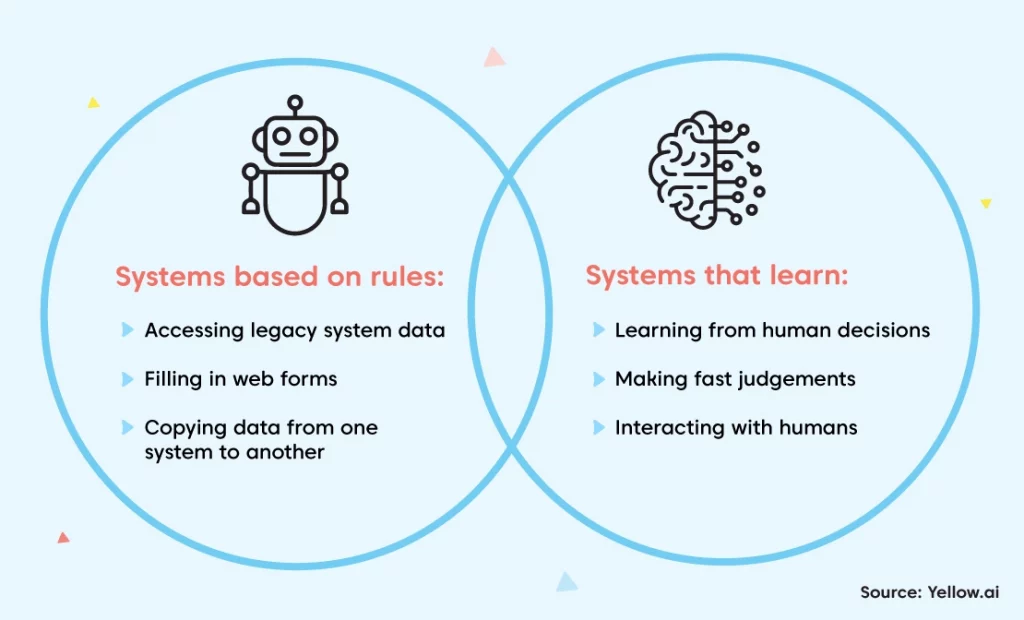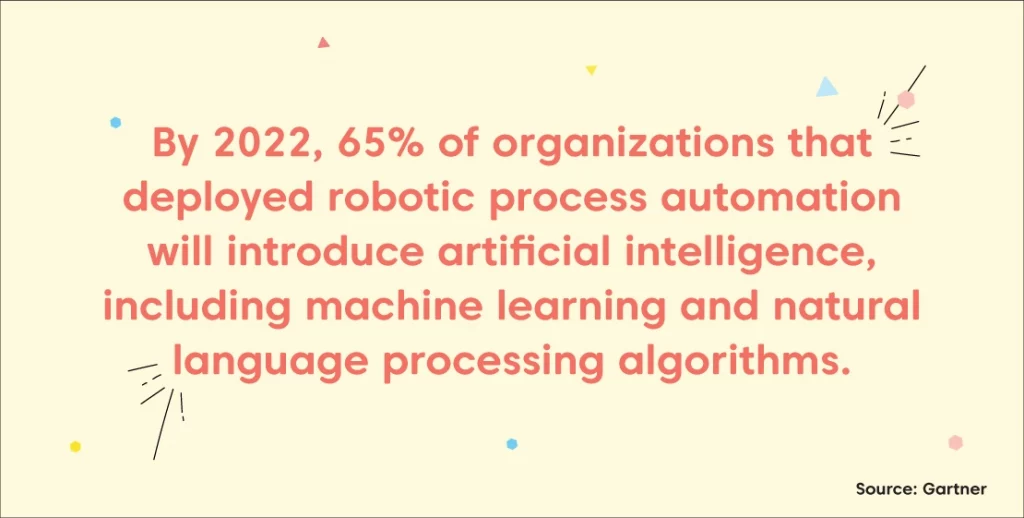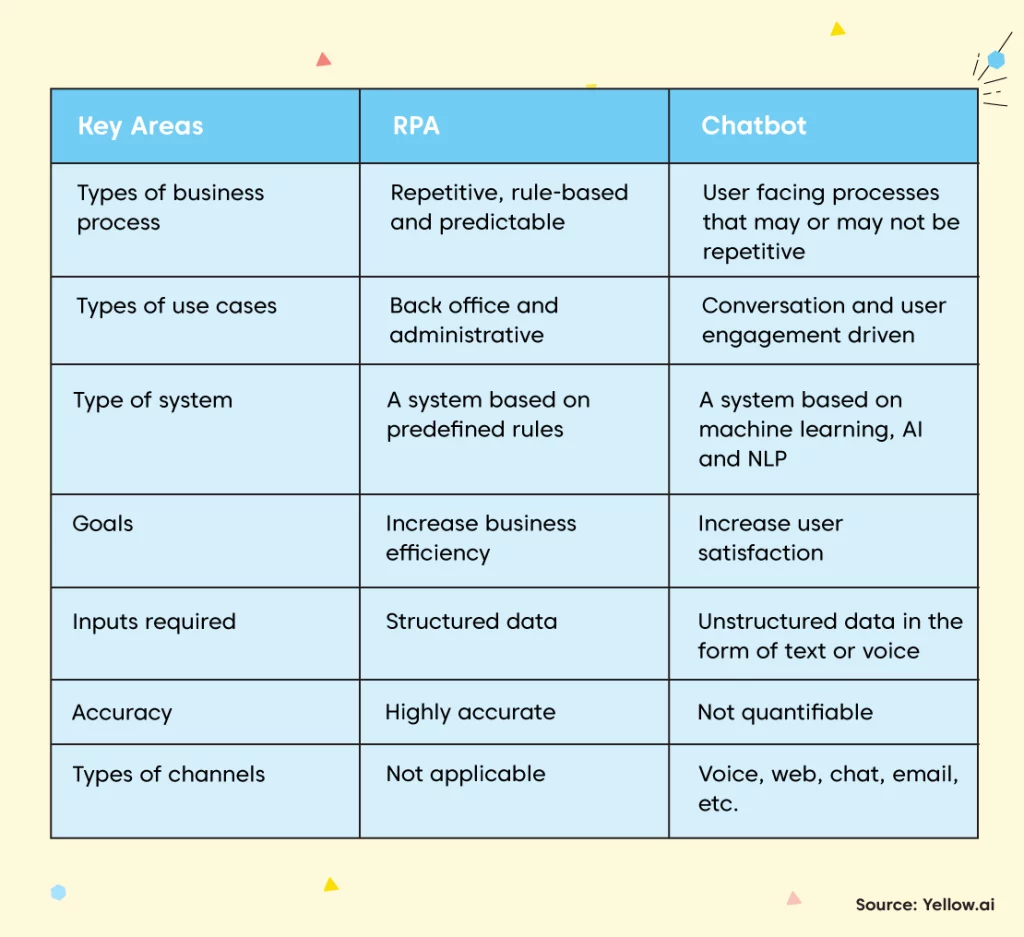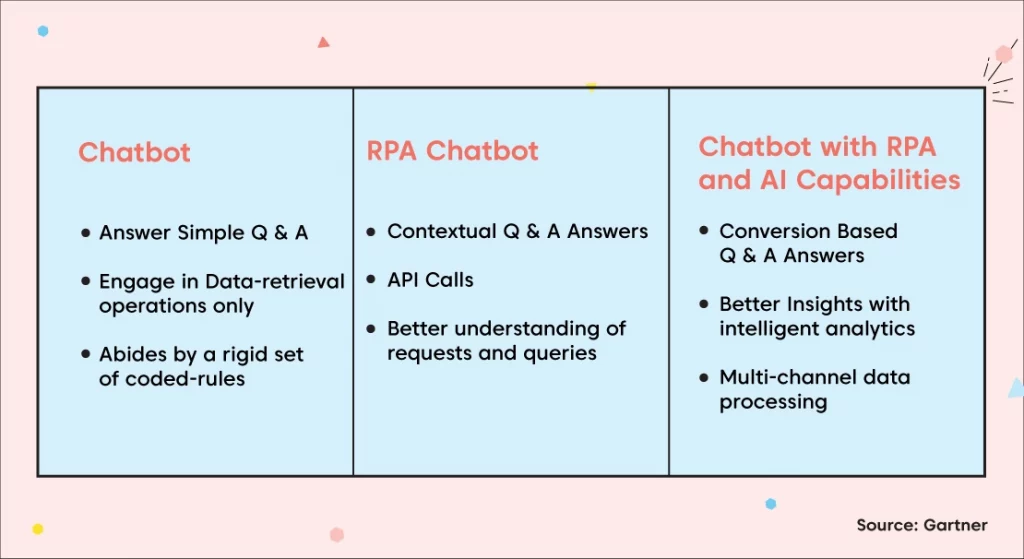We are entering a new era of hyper-automation where humans and machines will increasingly work hand-in-hand. Some of you might already be aware of the popularity of Chatbots and RPA in the automation ecosystem for enterprises. However, the bigger question is, what would happen if we integrate these two robust technologies?
In this article, we will explore how the intersection of RPA and conversational AI can increase business efficiency and how Yellow.ai is helping enterprises attenuate business problems by replacing rule-based models with advanced cognitive models.
What is Robotic Process Automation?
Robotic Process Automation (RPA) is the process of automating business operations with the help of bots to reduce human intervention. It increases organizational productivity by automating mundane tasks and streamlining end-to-end workflows, making organizations more agile, responsive and profitable.
RPA is a non-invasive way to implement and accelerate digital transformation, especially in industries that use legacy systems and lack APIs or virtual desktop infrastructures (VDIs).

RPA and chatbot integration
In a generic scenario, a chatbot interacts with a user, identifies their intent, and helps them complete the intended user journey. From a use-case perspective, a chatbot often integrates with systems like CRM and HRMS to fetch and store relevant information about the user. Often, these systems might not support APIs, which is where RPA plays a critical role.
Robotic Process Automation (RPA) can seamlessly integrate with chatbots and help the chatbot to complete a business process, access, or store information with legacy systems that do not have APIs. We have integrated with Robotic Process Automation (RPA) providers like UiPath, Automation Anywhere, etc seamlessly through APIs and other means as per the use-case.
Case study – Integration of Yellow.ai chatbot with UiPath RESTful API
Taking an example of our integration with UiPath, we consume their Orchestrator’s RESTful APIs to interact with our chatbot. As and when required, our chatbot gathers relevant user data, filters it in our platform through cloud functions for complex journeys and pushes the data in a queue or as queue items through relevant API calls.
When the RPA process is completed, an API call is made to our message API, whose payload contains data that needs to be processed in our platform or it needs to be reflected in the chatbot. In either of the cases, relevant data is posted to our chatbot within the same session for any unique user, thereby enabling bi-directional flow of data.
The bi-directional flow of data between our chatbot and Robotic Process Automation (RPA) allows our chatbot to orchestrate with RPA bots and processes. Enterprises get hard time-retaining their user’s when the RPA process is processed and ultimately users drop off which leads to increase in resolution time leading to bad user experience. With our intelligent chatbots and seamless bi-directional integration, enterprises need not worry about user drop off, slower resolution time and bad user experience.

Yellow.ai pre-built integration with tools like CRM, ERP, HCM, etc allows enterprises to quickly set up their flow without any additional efforts. Various scenarios demand many child chatbots to work with only one main chatbot, this is where our bot orchestrator (not the RPA orchestrator) plays a major role.
It uses a recommendation engine to suggest the most relevant responses and orchestrates among the most relevant bot in over 100+ languages across channels like WhatsApp, Google Business Messages, FB Messenger, etc.
RPA requires a procedural training of the process, i.e, it would require to be hand holded at various instances whereas our chatbot works on a semantic model for querying, which can be easily trained with words. With powerful Machine learning and NLP models, our chatbot’s self-learning capabilities and conversational insights are extensively helpful for enterprises to understand the end-user and their needs over time.
Our intelligent chatbots act as a front-facing layer that gathers, filters, and processes the user data while engaging with the user and running the RPA process in the back office.
How do chatbots and RPA differ?
Although chatbots and RPA, both automate essential business processes, they are two different technologies. RPA is typically used to automate back-end business processes. Whereas, chatbots excel in customer-facing scenarios where they solve customer problems by interacting with them in real-time.

How do chatbots and RPA compliment each other?
Business processes often require cognitive decision-making capability with optimization and a single tool like RPA cannot find scalable solutions alone. Yellow.ai bots, designed in a cognitive engagement cloud give an edge to your bot to achieve end-to-end automation. A couple of ways through which Chatbot and RPA compliments are:
1. Processes and inputs
Robotic Process Automation works well when the process is rule-based, repeatable, and predictable for structured data, whereas, our chatbot can work well for unstructured conversations for any specific use-case to trigger an RPA process.
2. Intelligence layer
Our chatbot, designed in a robust cognitive engagement cloud, intelligently identifies user intent, gathers data around it, and structures it as per the need of the RPA process. Our chatbot’s self-learning capability helps the automation process to make more intelligent decisions over time to streamline the business flow.
3. Real-time execution
Robotic Process Automation, integrated with a chatbot can handle complex and real-time queries from users at scale. Our chatbot helps the RPA process to gather real-time data from the user to process it and give relevant information back by enabling 2-way communication.
4. User experience
Traditional ways of gathering user data to run RPA bots, e.g, Surveys, Forms, etc. have drastically reduced user engagement as these forms of engagement require a waiting period for the users to get feedback. Having an intelligent chatbot deployed to make things convenient for users, gets a higher user engagement and a better experience.
Chatbot, being a front-facing layer, understands the intent of the user and simulates a human-like conversation, whereas the RPA bot echoes the activity of a human in the back-office. Ultimately, the chatbot understands the customer’s intent and Robotic Process Automation works behind the scenes to make it happen.

RPA and chatbot integration use cases
Think of it in this way, whenever and wherever you feel that a highly administrative, repetitive, rule-based and predictable task needs to be done in a legacy system by a human, an RPA can fit in to take over this mundane task. Generally, the human working on the mundane task would need some data to execute a business process in RPA, and if he/she is getting that data from an internal or external user, adding a chat or voice-based bot makes sense.
But wait! Would just adding a conversational channel suffice in achieving end-to-end automation? Well, that’s a straight no!
With Robotic Process Automation, enterprises can streamline a part of their automation, but to scale beyond this initial plain sailing process, business leaders are taking a step further with us. Data is the new oil, and we kid you not when we say this; that we help leaders capture meaningful data which creates an actual impact on the business.
Meaningful data that you had been losing all up until now. As a business, you have some information that needs to go through a repetitive process and you use Robotic Process Automation and get the output; now imagine having a digital conversational interface that can capture user’s sentiment, intent, engagement frequency, and a lot more, with enabling the same RPA process that too with a fraction of the time taken earlier! The more you dig with us, the more data will be captured by our bot.
Common use-cases of AI and NLP working together with RPA are not limited to but include various industry and domain-specific scenarios like:
1. Insurance Claims
An insurance claim is a complex process that involves multiple interactions that are handled by different systems and employees. A claim usually starts when a customer reports an accident to your bot.
Without integrating your bot with the back-end RPA systems, it won’t be able to access the customer’s policy information so as to update them on eligible services and relevant information. This is where RPA comes in. Once a claim is made, the bot can gather supporting information to the customer, log it directly into appropriate systems.
2. Customer Service
Customers hate waiting on hold. They prefer instant resolution of their queries at their preferred time, in their preferred language. Most importantly, customers don’t like repeating themselves and expect seamless personalized experiences.
Rather than offering legacy touch-tone menus to your customers, businesses must use chatbots that can understand natural language and can turn to RPA software to retrieve relevant customer data from the appropriate systems. This way, chatbots will be able to offer tailored communications that will increase user satisfaction.
3. HR Virtual Assistant
HR, on a daily basis, spends a lot of time answering repetitive questions about the organization’s policies, framework and processes. With the help of RPA bots, HR can offer a self-service option to the employees.
With RPA, chatbots will be able to retrieve and analyze relevant information to offer accurate solutions to repetitive employee queries. RPA chatbots give HR the capability to do more in less time. In other words, they help HR manage mundane tasks and processes, ultimately freeing up their time to focus on developing, engaging and inspiring talent.
To Sum Up
RPA and chatbot integration can solve some of the major challenges faced by modern enterprises today. It enables chatbots to trigger RPA to perform a specific task based on the user’s query. This means that there would be little to no human intervention, leading to reduced operational costs as well as an increase in organizational productivity and efficiency.
At Yellow.ai, we natively integrate leading RPA platforms with our AI-powered chatbots to enable end-to-end automation for your business. Request a demo and our experts will help you get started!


















